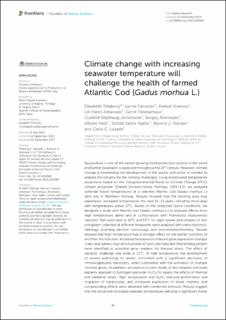| dc.description.abstract | Aquaculture is one of the fastest growing food production sectors in the world and further expansion is expected throughout the 21st century. However, climate change is threatening the development of the sector and action is needed to prepare the industry for the coming challenges. Using downscaled temperature projections based on the Intergovernmental Panel on Climate Change (IPCC) climate projection (Shared Socioeconomic Pathway, SSP2-4.5), we analysed potential future temperatures at a selected Atlantic cod (Gadus morhua L.) farm site in Northern Norway. Results showed that the farming area may experience increased temperatures the next 10–15 years, including more days with temperatures above 17°C. Based on the predicted future conditions, we designed a study with Atlantic cod (Gadus morhua L.) to evaluate effects from high temperature alone and in combination with Fransicella noatunensis infection. Fish were kept at 12°C and 17°C for eight weeks and samples of skin and spleen collected at different timepoints were analysed with transcriptomics, histology, scanning electron microscopy and immunohistochemistry. Results showed that high temperature had a stronger effect on the barrier functions of skin than the infection. Increased temperature induced gene expression changes in skin and spleen, heat shock protein 47 and cold inducible RNA binding protein were identified as potential gene markers for thermal stress. The effect of bacterial challenge was small at 12°C. At high temperature, the development of severe pathology in spleen coincided with a significant decrease of immunoglobulins transcripts, which contrasted with the activation of multiple immune genes. In addition, we used an in vitro model of skin biopsies and scale explants exposed to hydrogen peroxide (H2O2) to assess the effects of thermal and oxidative stress. High temperature and H2O2 reduced proliferation and migration of keratocytes, and increased expression of stress markers, and compounding effects were observed with combined stressors. Results suggest that the projected increased seawater temperature will pose a significant threat to Norwegian cod farming, affecting various biological processes and making fish more vulnerable to stressors and pathogens. Cod farming needs high attention to temperature changes, and special precautions should be taken if the temperature increases beyond cods’ thermal optimum. | en_US |
